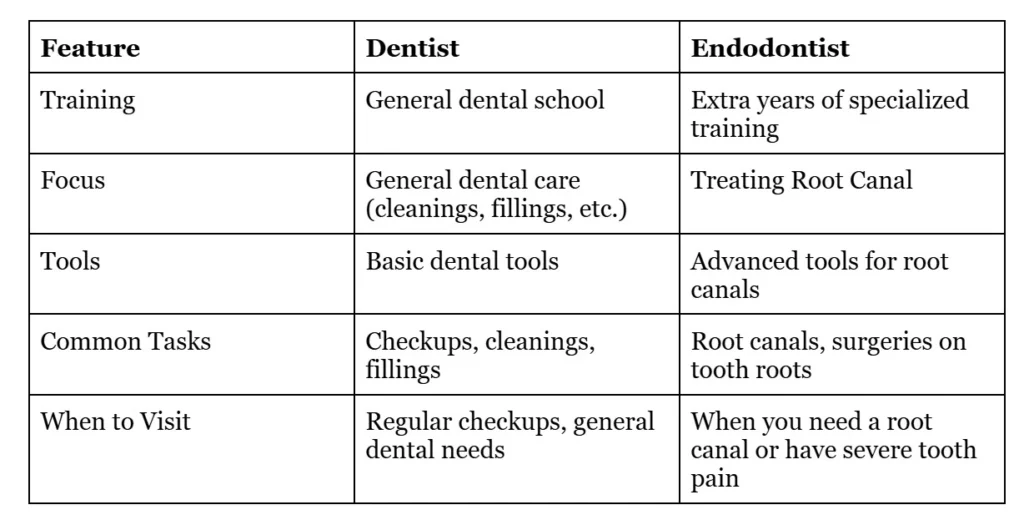What Procedures Does an Endodontist Perform
Have you ever experienced a horrible toothache that wouldn’t go away? Or perhaps your dentist told you that you needed a “root canal”? If you have, you may have heard of an endodontist. But what exactly is an endodontist, and what do we do? It may sound like a big, scary word, but it is just getting your teeth to stay healthy! Let’s dive into this specific type of dentist and why they are such a valuable part of your health team.
What is a Root Canal?
A root canal is a dental procedure that’s used to treat and save a tooth that’s badly infected or damaged. Put simply, a tooth has a soft tissue (the pulp) inside it that contains nerves and blood vessels. Root canals aim to fight the infection and preserve the natural tooth to prevent extraction. Preservation of tooth function is important for chewing, speaking, and maintaining the proper alignment of other teeth.
What Does an Endodontist Do?
An endodontist is a dentist who finds and treats problems inside your teeth. Regular dentists clean teeth, fill cavities, and look for tooth decay; endodontists go deeper. They handle the whole area of the tooth, the pulp, which contains nerves and blood vessels. The most frequent treatment they perform is known as a root canal. This is when they remove the infected or damaged pulp from the tooth, fill it, and seal it so the pain is gone and the tooth remains in place.
Endodontists are sometimes referred to as root canal specialists because they perform this type of treatment daily. In a nutshell, an endodontist is a dentist who specializes in inner tooth treatment when the pulp is infected, weak, or very painful. These are the people you go to when a normal dentist tells you that a tooth requires special treatment to be saved.
What does an Endodontist do besides root canals?
While endodontists are commonly referred to as root canal specialists, they do so much more. They are dental specialists who manage the inside part of your teeth, mainly the pulp and nerves. Some other big things endodontists do beyond root canals:
1. Find out the real cause of tooth pain: It’s not always clear why your tooth hurts. An endodontist can pinpoint the source of the discomfort, even if it’s deep inside the tooth or difficult to see.
2. Fix cracked or broken teeth: If you have a cracked or broken tooth, an endodontist can treat the tooth before it gets worse. Some of the cracks go deep into the root of the tooth, which typical dentists may not be able to treat effectively.
3. Treat dental injuries(sports accidents): If you fall, are hit, or otherwise have a tooth knocked out, pushed in, or broken, an endodontist can help save your tooth. They know how to treat injuries and try to save your natural tooth.
4. Manage patients with aberrant tooth morphology: Other angles and curves can be something only an endodontist knows how to approach. They’re trained to handle complex root shapes.
5. Make the patient comfortable and relieve pain: Endodontists save the day by treating the source of the pain and allowing the tooth to repair itself. They emphasize the impermanence, saving teeth, and reducing pain.
6. Co-work with specialists and general dentists: If something serious is found by your regular dentist, they may refer you to an endodontist. They are pretty much like the dentist’s mechanics by diagnosing and fixing difficult problems on the inside of teeth.
Endodontist vs Dentist: What’s the Difference?
Here are some of the major differences between a dentist and an endodontist:

Why is there a need to visit to Endodontist?
You need an endodontist when the soft tissue inside your tooth, also known as the pulp, becomes infected or damaged. It can be extremely painful and irritating. If the pulp is infected, it will not self-heal, and pulling the tooth is not always anoptimal course of action. The loss of a tooth can cause issues with chewing and speaking, as well as with thealignment of your remaining teeth. This infected pulp will need to be cleaned out and sealed up.
So, accordingly, if you have a toothache that won’t go away, sensitivity to hot or cold, or swelling near your gums, your regular dentist will likely refer you to an endodontist. They can recognize and treat these conditions, allowing you to save your natural teeth and keep your mouth healthy.
What Happens During a Root Canal?
A root canal is a normal and safe treatment that will save your natural tooth. We’ve outlined the process below step by step so you know what to expect.
1. Numbing the Tooth
I – The first is ensuring that you’re not in pain.
II – The endodontist will give you a medication known as a local anesthetic.
III – This is done by using a small injection in the area of your tooth.
IV – It’ll feel like a little pinch for a second, but after that, the area is completely numb.
2. Cleaning the Inside
I – Once the tooth is numb, the endodontist will drill a small hole in the top of your tooth.
II – This hole allows them to get to your pulp, the soft inner part of your tooth.
III – A deep cavity, crack, or injury can also cause infection or damage to the pulp.
IV – The endodontist will remove all the sick or dead pulp using special tools.
V – Cleaning inside your tooth to remove germs and bacteria.
3. Filling the Tooth
I – When that tooth is nice and clean, the endodontist will fill in that space inside.
II – They pack it with a soft, rubbery substance called gutta-percha.
III – This keeps the tooth strong and prevents germs from returning.
IV – Because the filling goes all the way down into the root, this means that the inside here is completely sealed.
4. Sealing the Tooth
I – Once the dentist has filled the tooth, the top of the tooth needs to be sealed.
II – A tiny filling is put over the hole that was created in the first place.
III – This protects the tooth and prevents food or bacteria from getting back inside.
IV – This stage is sometimes handled by your regular dentist after the root canal.
5. Adding a Crown
I – After undergoing the procedure of a root canal, your tooth may be slightly weaker.
II – To safeguard this, your endodontist or dentist may suggest putting a crown on top of it.
III – A crown is like a hard hat that encases your tooth and makes it strong enough to chew with.
IV – It further makes your tooth resemble all the others.
Conclusion
Endodontists are dental specialists who do far more than root canals. They target the conservation of natural teeth by addressing issues on the interior, such as infections, injuries, and pain in the pulp or root of the tooth. Equipped with specialised training, tools, and a gentle touch, they can take care of very complex tooth problems that general dentists may not be equipped to treat. Their primary objective is ensuring you are comfortable and pain-free and that you maintain your natural teeth when possible. So the next time you hear endodontist, remember they’re the tooth-saving heroes behind the curtain.
If you’re dealing with tooth pain, a cracked tooth, or a failed root canal, don’t wait! Talk to your dentist or schedule a visit with a trusted endodontist today. Saving your natural tooth is easier than you think—let the experts help you smile pain-free!
Frequently Asked Questions About Endodontists
Do you still have questions about what an endodontist does? Read below:
1. What is an endodontist?
An endodontist is a special kind of dentist who focuses on treating the inside of your teeth, especially the part called the pulp (which has nerves and blood vessels). They help save teeth by treating deep infections, injuries, and pain.
2. Do endodontists perform only root canals?
No, they can do way more than root canals! In addition to treating inflamed or infected teeth, endodontists also treatcracked teeth, repair injured teeth, perform root canal retreats, and do minor surgeries to help save your tooth.
3. When do I need to see an endodontist?
You will need to return to see an endodontist if there is serious tooth pain, a deep cavity, or a tooth injury. If your dentist believes that your tooth problem is more complicated, he or she may refer you to an endodontist for specialized care.




